Crown Prosecution Service Joint Enterprise Pilot 2023: Data Analysis
Joint Enterprise pilot – background
The CPS commenced a pilot to monitor Joint Enterprise homicide/attempted homicide cases in February 2023. “Joint enterprise”, or secondary liability, is a legal doctrine that applies where persons assist or encourage another to commit a crime. These persons are known as accessories or secondary parties.
Where two or more persons are involved in an offence, the parties to the offence may be principals (D1) or secondary parties (accessories) (D2). Each offence will have at least one principal, although it is not always possible or necessary to identify the principal(s).
A principal is one who carries out the substantive offence i.e., performs or causes the actus reus of the offence with the required mens rea. If two or more persons do so, they are joint principals.
A secondary party is one who aids, abets, counsels or procures (commonly referred to as assists or encourages) D1 to commit the substantive offence, without being a principal offender. For example, in a burglary, the person who enters a property and steals something is the principal, whereas the person who acts as a lookout or driver is a secondary party. The secondary party can be prosecuted and punished as if he were a principal offender.
Secondary liability principles can be applied to most offences. The principles remain the same, whichever offence they are applied to. The principles are commonly used in offences of violence, theft, fraud and public order.
The CPS prosecution guidance on Secondary Liability: charging decisions on principals and accessories sets out how charging decisions are to be approached by prosecutors in cases involving persons who assist or encourage another to commit a crime.
Joint Enterprise – CPS data limitations
The CPS Case Management System (CMS) does not enable Joint Enterprise cases to be ‘flagged’ and therefore extracted for a more detailed manual assessment of case features. However, given ongoing concern regarding disproportionality in Joint Enterprise prosecutions, the CPS has commenced a pilot scheme whereby homicide and attempted homicide cases prosecuted on a joint enterprise basis are ‘flagged’ manually in six of the fourteen CPS Areas – London North, Mersey-Cheshire, North East, North West, West Midlands, and Yorkshire and Humberside.
Flagged cases were manually reviewed to identify case features of particular interest – the number of defendants associated with each case, whether these defendants were the ‘principal’ or ‘secondary’, demographic details regarding the defendant, and whether the case was considered to fall within the definition of ‘gang’ related offending as set out in CPS prosecution guidance. Cases which were live upon the commencement of the pilot were flagged, in addition to any new relevant cases referred to the CPS in these Areas.
Further, the CPS has convened a ‘scrutiny panel’ to review two finalised Joint Enterprise cases, selected from the sample gathered for this pilot. The scrutiny panel comprised a number of experts in the field of Joint Enterprise, from a legal, academic, and specialist voluntary sector background.
Joint Enterprise pilot – pilot data
The flag has been applied to all live, pre-charge and post charge cases in the CPS case management system since February 2023. Some of those cases have since been finalised. The flag has been piloted in CPS London North and South, Mersey Cheshire, North East, North West, West Mids, and Yorkshire and Humberside.
The data has been drawn from two sources – (1) the CPS Case Management System (CMS), which captures some useful for the purposes of this pilot, and (2) data collected manually by CPS Areas specifically for this pilot project.
The data does not refer directly to CPS decision-making – it refers to the entire CPS caseload for joint enterprise homicide and attempted homicide in the pilot Areas since the pilot started. Conclusions regarding CPS decision-making cannot be drawn from the data in this pilot. Data on defendants, including demographic data, is passed to the CPS by the police. The data is not complete, though the CPS has endeavoured to fill as many gaps as possible.
The overall sample includes 190 cases and 680 defendants. This is a relatively small sample size when broken down by CPS Area, case feature, defendant characteristics, and other variables captured in the pilot. Given that one case will likely feature several defendants, single cases can have a significant impact on patterns in the data. Strong conclusions cannot be drawn from this analysis.
Number of cases and status by defendant
London has the largest number (79) of cases in the sample, and Mersey-Cheshire has the smallest (6). This is to be expected, given their relative size. Note that, given the small number of cases, in Mersey-Cheshire and the North East in particular, patterns in the data at an Area level will be affected by small numbers of cases.
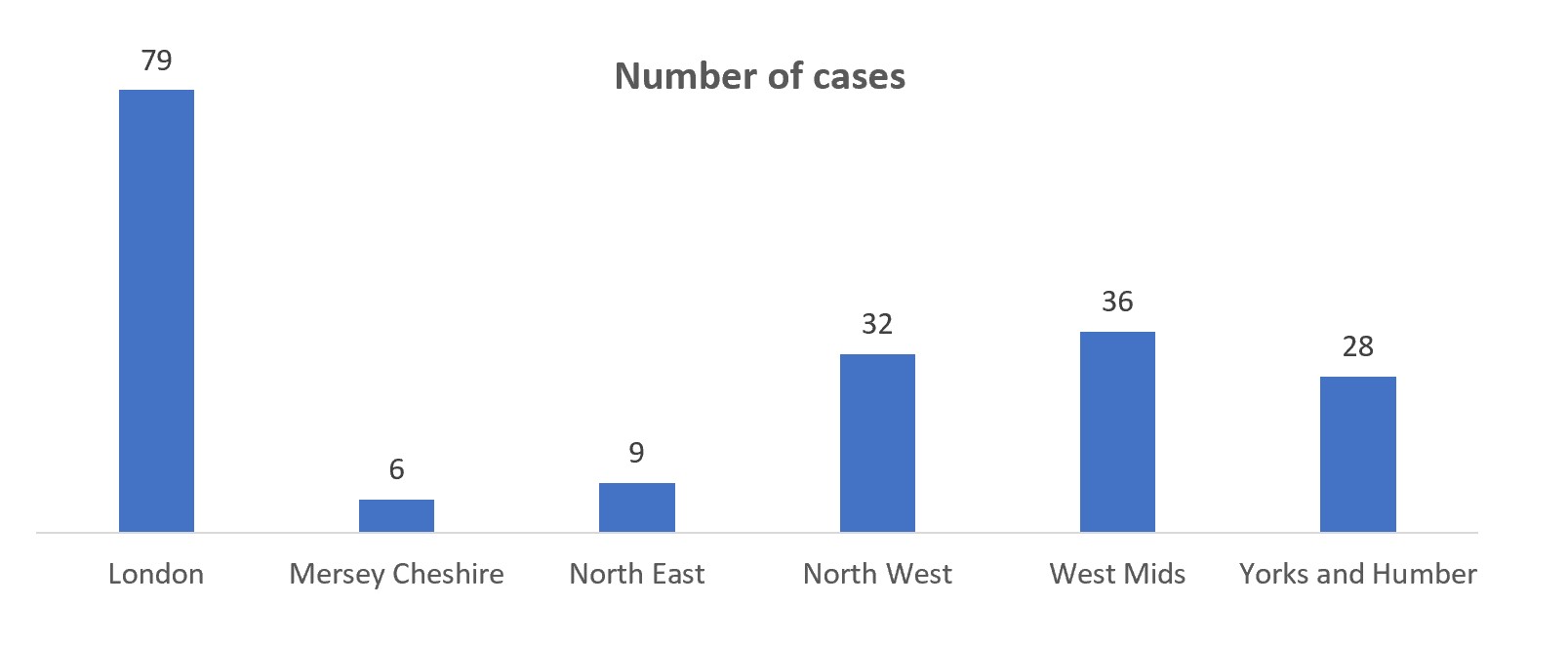
| CPS Area | Number of cases |
|---|---|
| London | 79 |
| Mersey-Cheshire | 6 |
| North East | 9 |
| North West | 32 |
| West Midlands | 36 |
| Yorkshire and Humberside | 28 |
| Total | 190 |
In regard to the status of the prosecution process regarding each defendant at the time of data analysis, the majority in the sample are either live (431) or finalised (209).
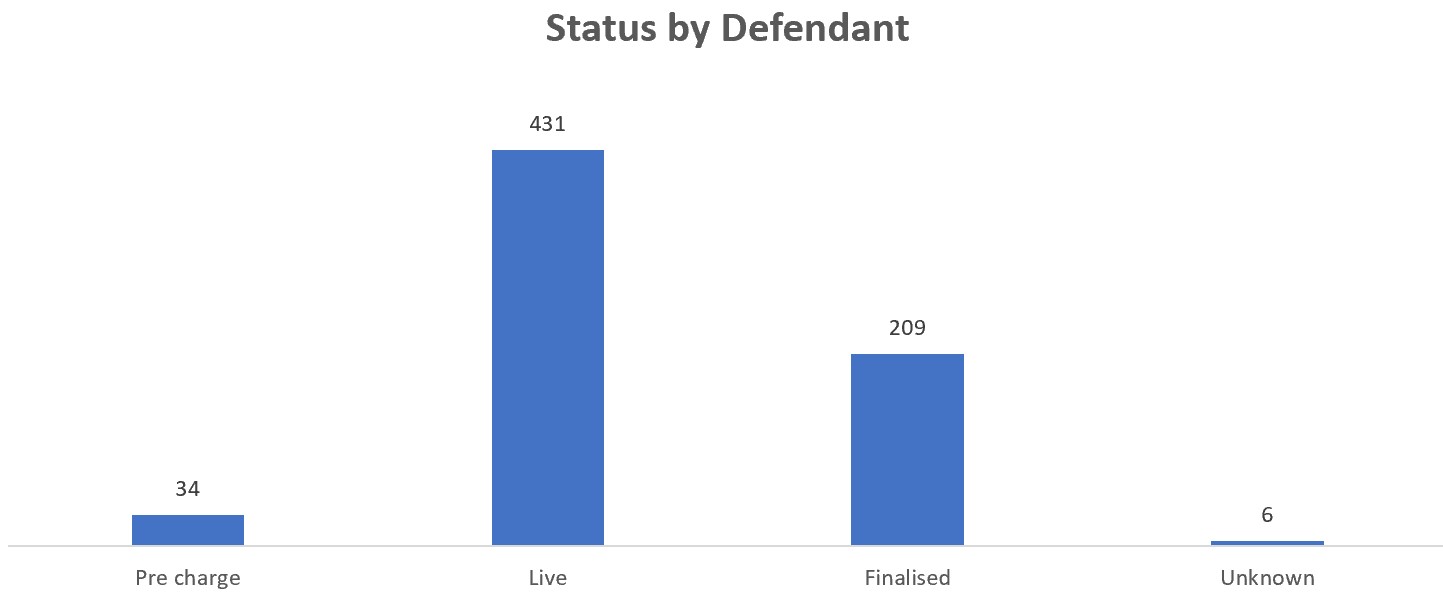
Gang-related
The definition of ‘gang’ is set out in CPS prosecution guidance on gang-related offending – prosecutors should not refer to a group as a ‘gang’ in proceedings unless there is evidence to support the assertion. Using the term “gang” inappropriately risks casting the net of liability beyond that which can be established. It also disproportionately affects minority ethnic people. For these reasons, prosecutors must not use the term “gang” unless there is evidence to support that assertion.
Cases falling within the definition set out in the guidance have been marked as such. Overall, 39 of 190 cases (21%) were considered ‘gang-related’, though the proportion of ‘gang-related’ cases varies across CPS Areas. London features the highest proportion (33%), in comparison with Mersey-Cheshire, which features zero.
| Cases considered 'gang-related' by CPS Area | Yes | No | Unknown |
|---|---|---|---|
| London | 26 | 53 | 0 |
| Mersey-Cheshire | 0 | 6 | 0 |
| North East | 0 | 8 | 1 |
| North West | 4 | 28 | 0 |
| West Midlands | 7 | 29 | 0 |
| Yorkshire and Humberside | 2 | 26 | 0 |
| Total | 39 | 150 | 1 |
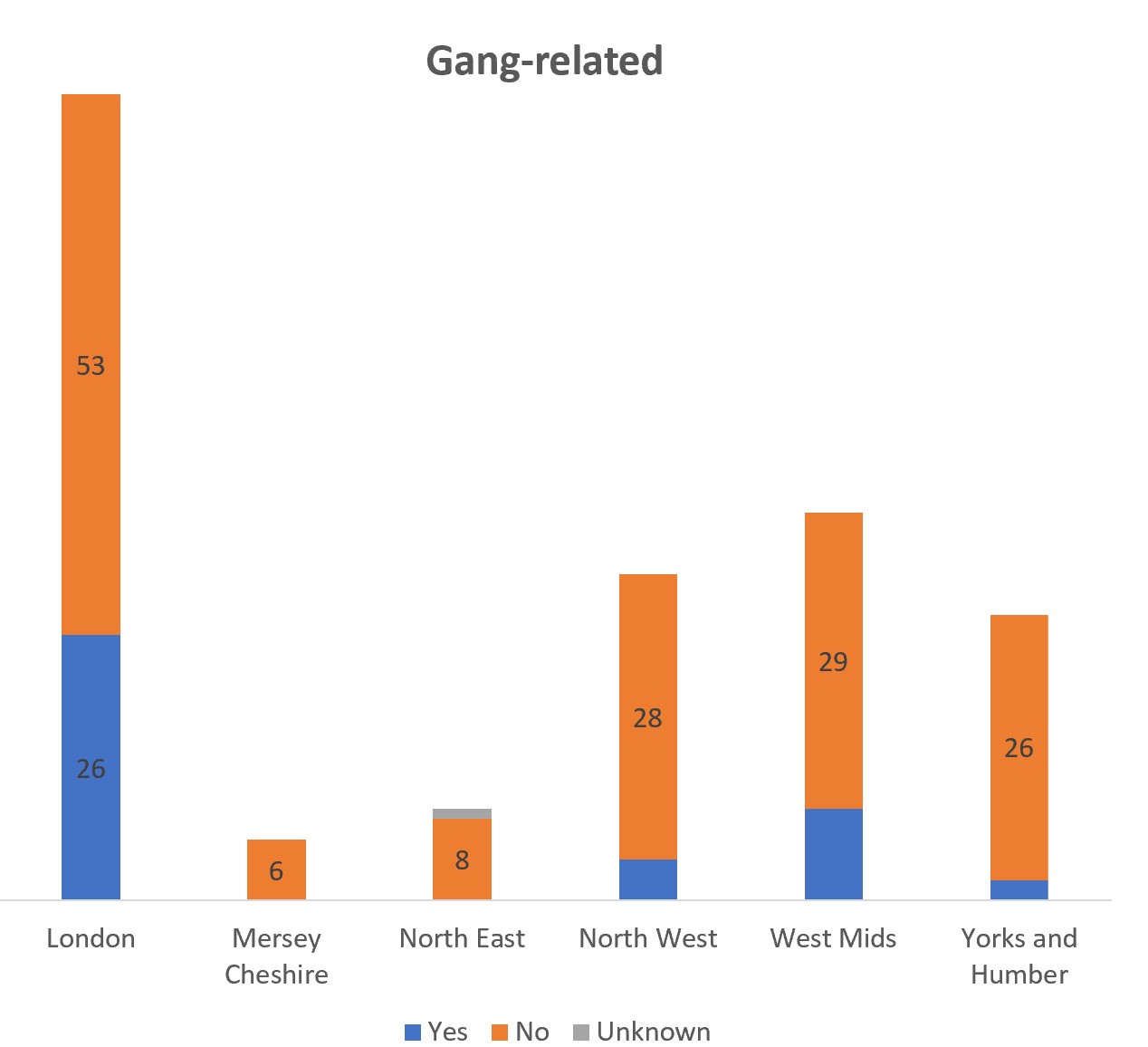
Defendants per case/frequency
Joint Enterprise cases should, by definition, feature more than one defendant.
In general, cases featuring fewer defendants are most prevalent in the sample – 34% of cases in the sample feature two (2) defendants, and 80% of cases feature 4 or fewer defendants.
Nine (9) cases in the sample have one (1) defendant. This most likely reflects cases where one of a number of suspects has been identified.
To note - There are cases with one defendant, as sometimes despite the evidence indicating that the alleged offence(s) were committed by multiple suspects, only one out of a number of suspects is identified, but these offences can be prosecuted on a joint enterprise basis. Alternatively, there can be a situation where there are a number of suspects, some are charged but one or more may abscond including, sometimes, leaving the country, meaning that they cannot all be tried together. Once the absent individual is traced, and for example extradited if they have fled abroad, they can be prosecuted on a Joint Enterprise basis.
| CPS Area | Number of cases |
|---|---|
| London | 79 |
| Mersey-Cheshire | 6 |
| North East | 9 |
| North West | 32 |
| West Midlands | 36 |
| Yorkshire and Humberside | 28 |
| Total | 190 |
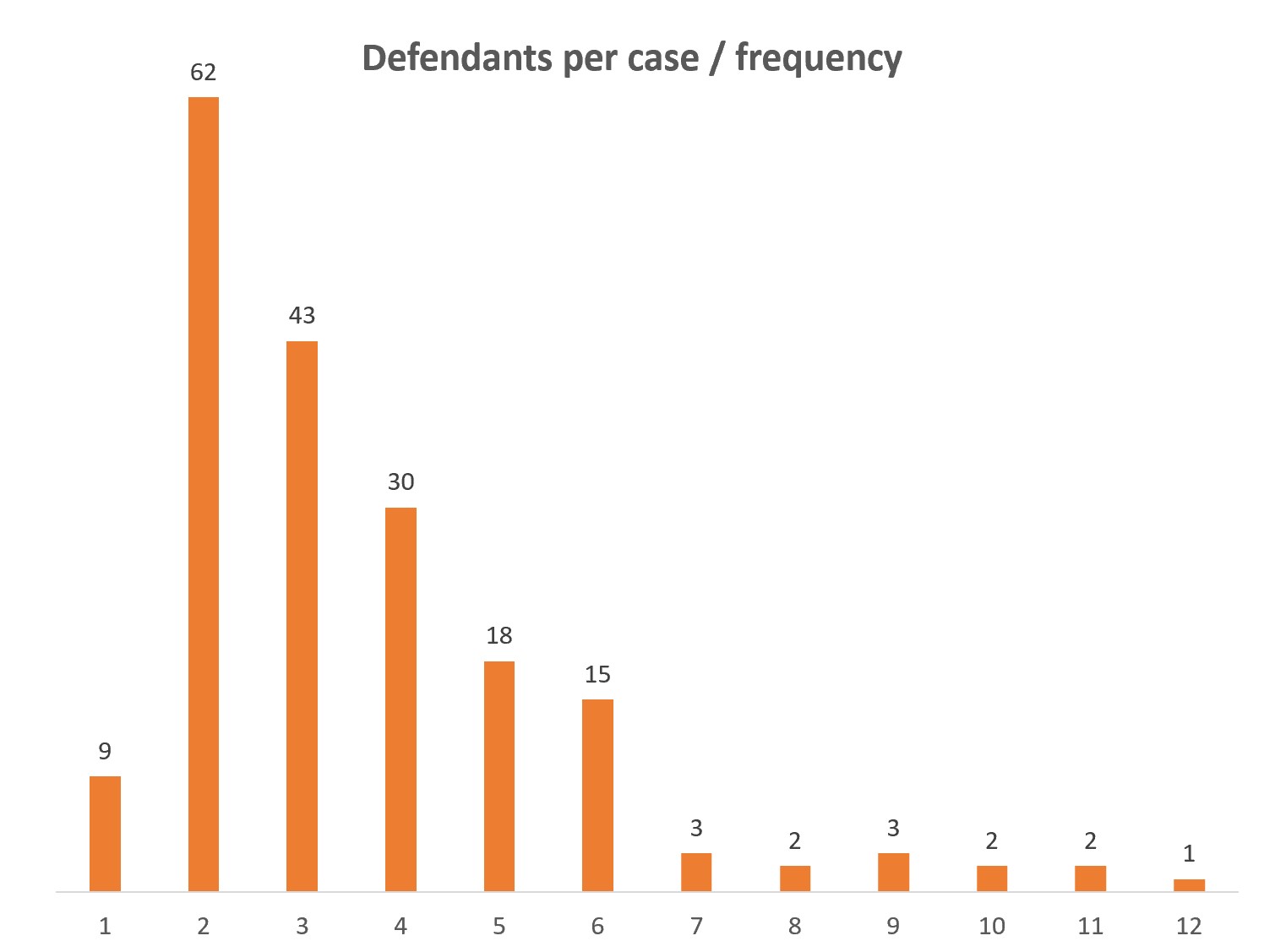
Average number of defendants per case
The average number of defendants per case can be compared across Areas. Yorkshire and Humberside has the lowest overall average. In all Areas, the average number of principal defendants exceeds the average number of secondary defendants per case. This reflects the nature of the offending, whereby the ‘principal’ defendants are considered to have committed the offence, and the ‘secondary’ defendants have assisted the principal in the commission of the offence.
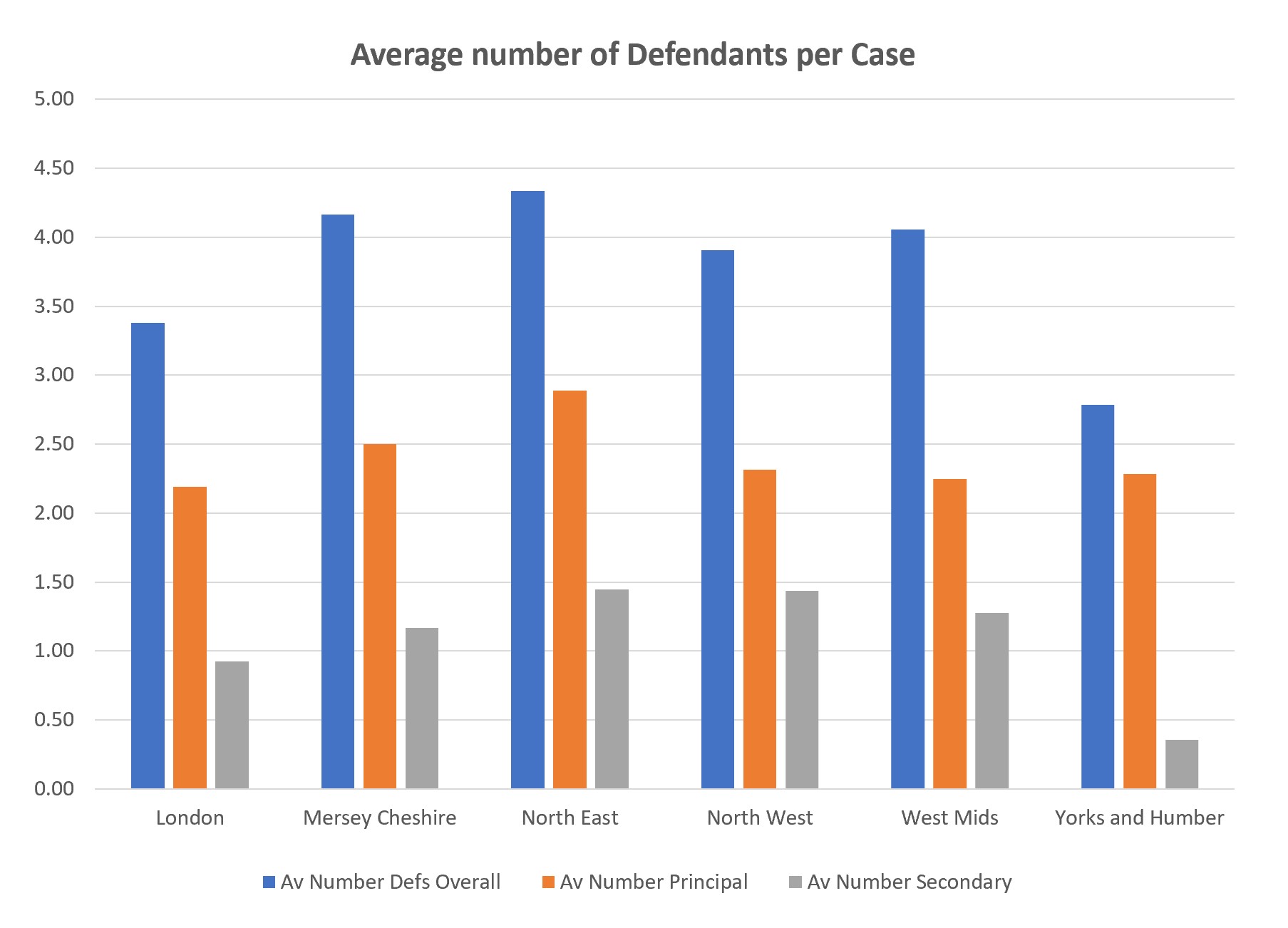
Age - overall
The largest age category is 18-24, with almost 40% of defendants falling in this age range.
| Age | Overall number | Overall percentage |
|---|---|---|
| 14-17 | 95 | 13.97% |
| 18-24 | 271 | 39.85% |
| 25-29 | 102 | 15.00% |
| 30-59 | 203 | 29.85% |
| 60-69 | 7 | 1.03% |
| Unknown | 2 | 0.29% |
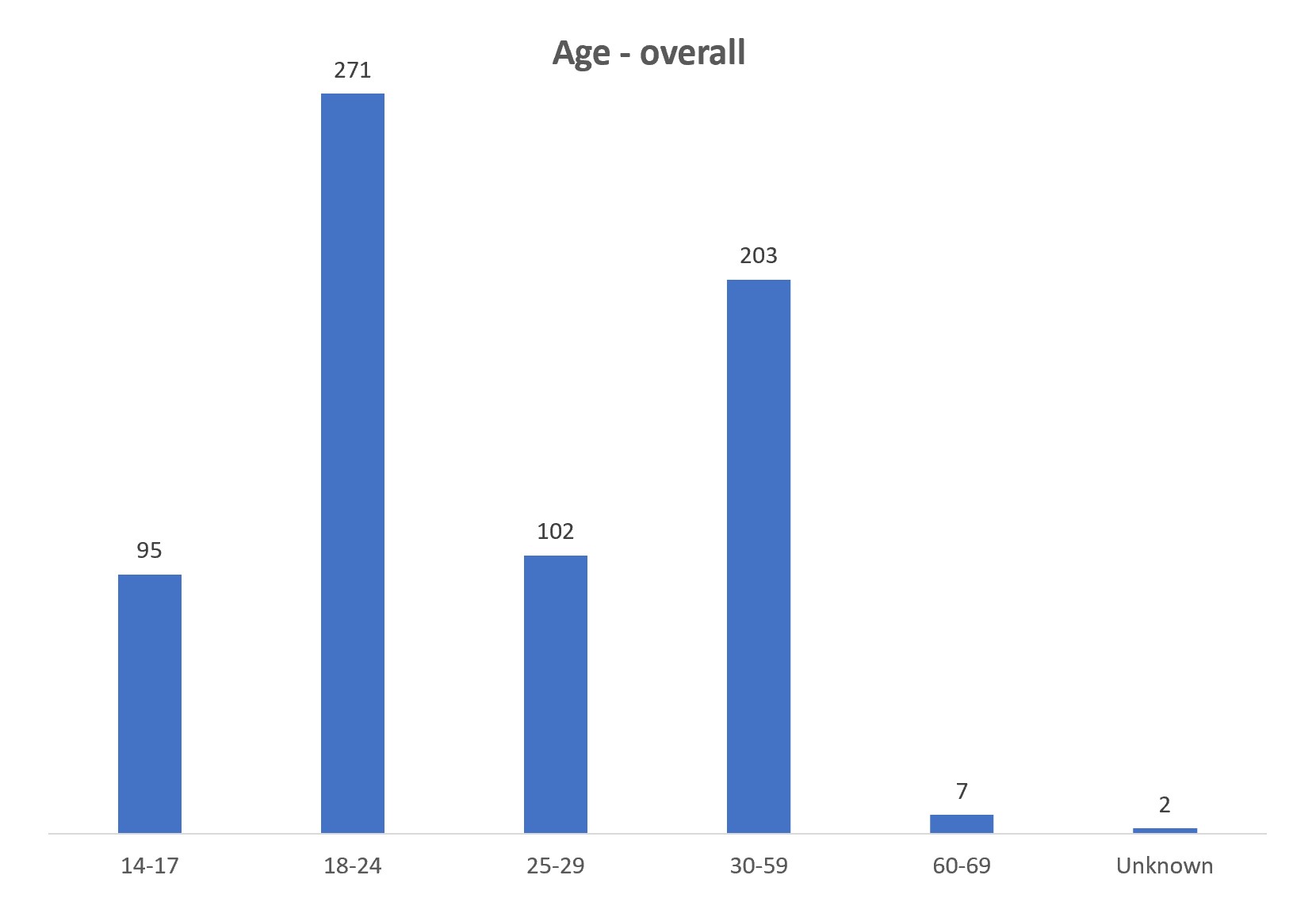
Age - Area breakdown
Comparing the age categories of defendants across CPS Areas, there are clear differences. In London, for example, over 60% of defendants are under 25, compared with less than 30% of defendants in Mersey-Cheshire. The North East has the highest proportion of defendants in the youngest category (14-17). Note that all defendants in this category in the North East belong to a single case. This emphasises the way in which a single case affect patterns in the data, given the low numbers of defendants/cases at an Area level.
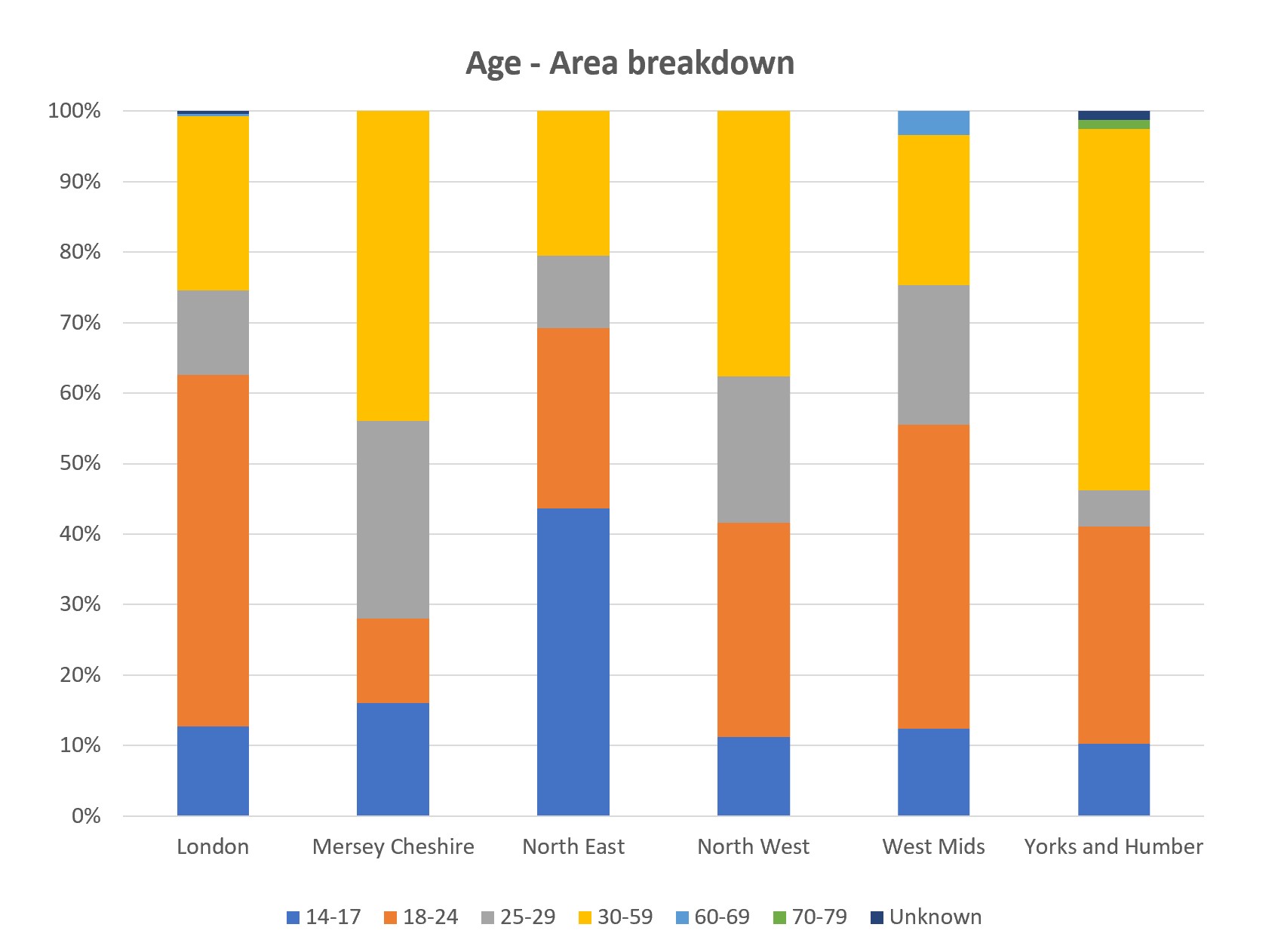
Sex
Almost 93% of defendants are male. Of the 47 female defendants, there is an even split across principal and secondary categories.
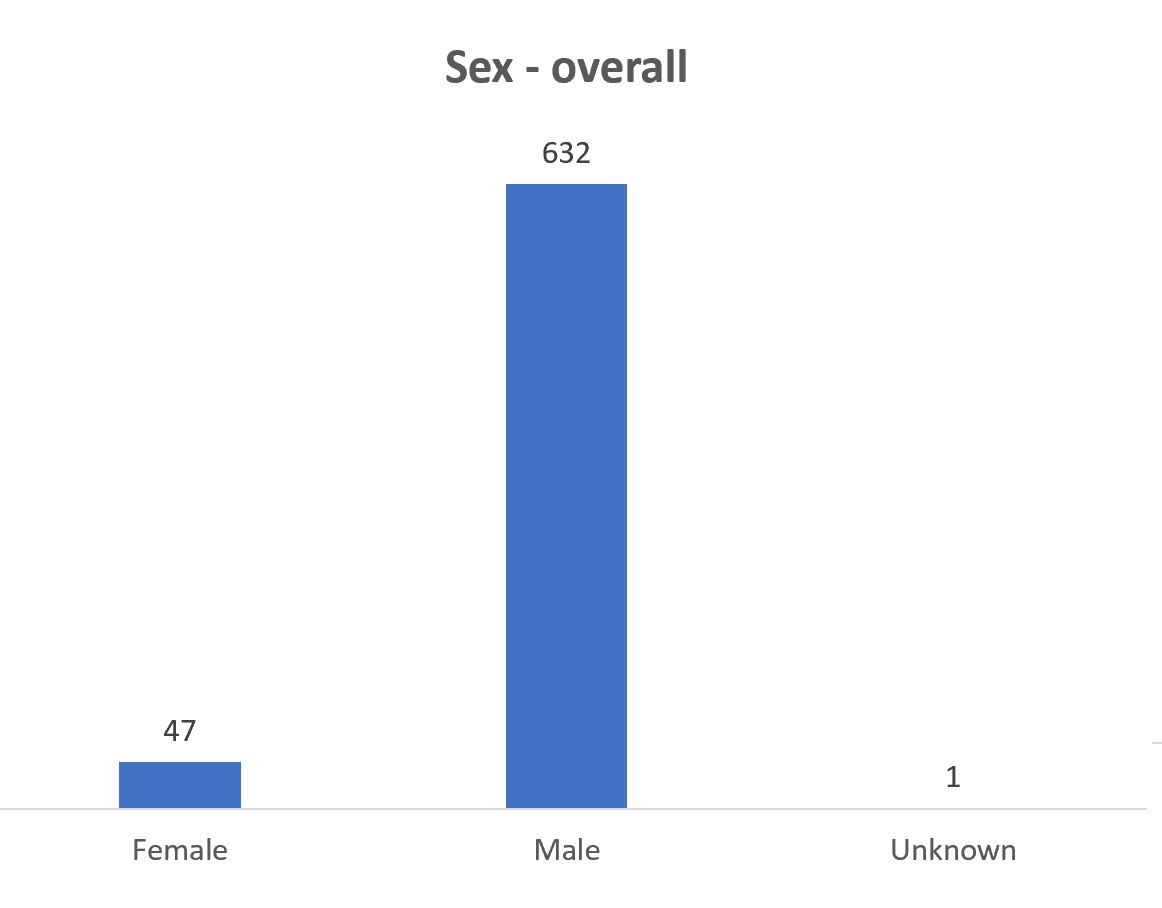
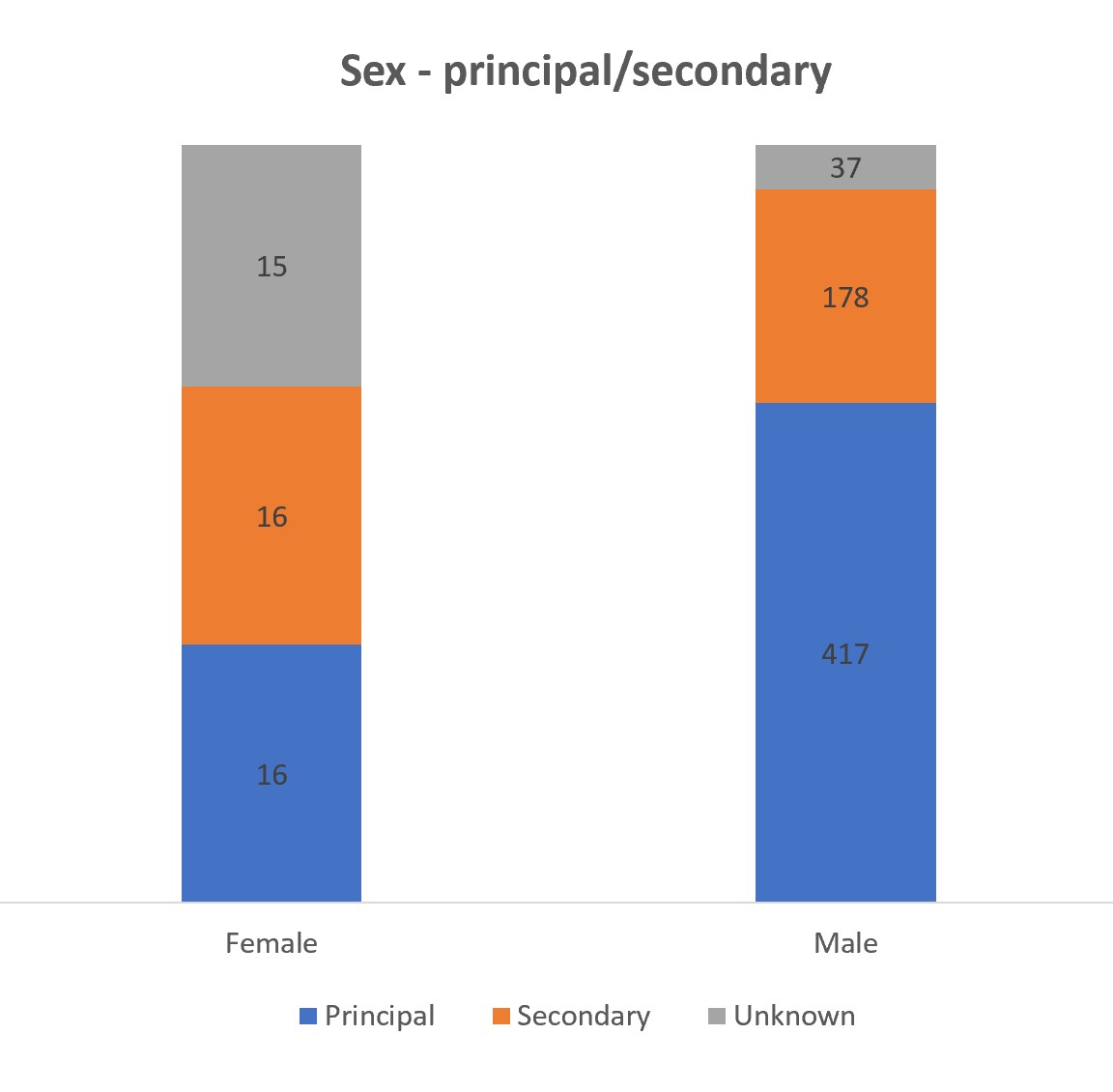
Disability - overall
Approximately 5% of defendants were considered to have a disability, based on information available to the CPS. Details regarding the nature of disabilities are not available for all defendants, and recording is inconsistent. However, in general, based on the information available, no defendants in the sample have a physical disability. ADHD, anxiety, depression, PTSD, and autism spectrum disorder are all noted.
| Disability | Number | Percentage |
|---|---|---|
| Yes | 37 | 5.44% |
| No | 518 | 76.18% |
| Unknown | 125 | 18.38% |
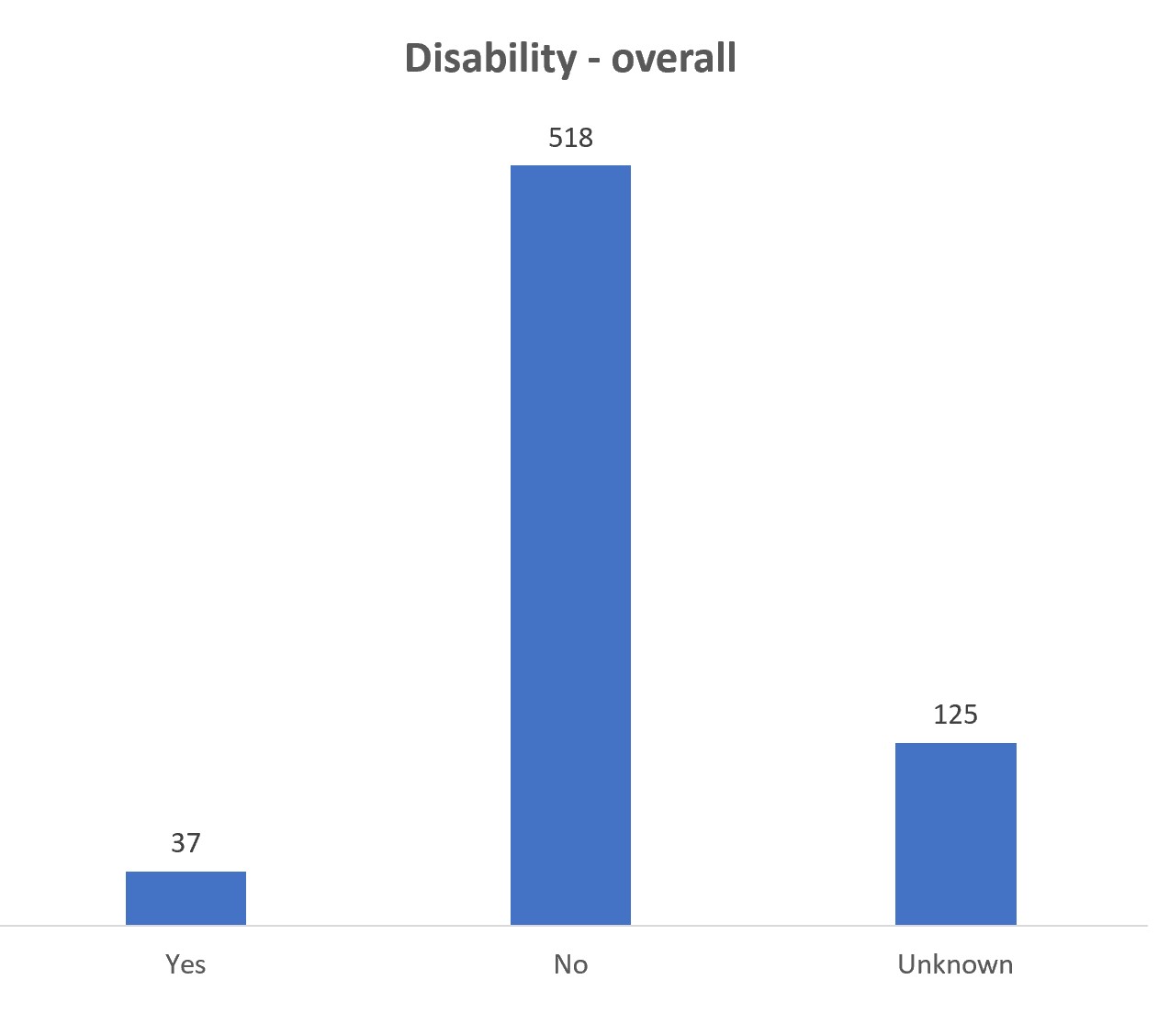
Ethnicity by population and by CPS caseload overall
The largest category is ‘White’, with approximately 39% of defendants falling into this category. ‘Black’ is the next largest, at approximately 30%, followed by ‘Asian’ at approximately 14%.
The CPS caseload can be compared with the overall population for England and Wales, based on the ONS/census data, in regard to the ethnicity of defendants. For ‘Asian’, ‘Black’, ‘Mixed’ and ‘Other’, the proportion in the CPS caseload exceeds the overall population.
| Ethnicity | In population | In CPS caseload |
|---|---|---|
| Asian | 9.25% | 13.97% |
| Black | 4.04% | 30.15% |
| Mixed | 2.88% | 8.38% |
| Other | 2.11% | 3.24% |
| White | 81.71% | 38.97% |
| Unknown | 0.00% | 5.29% |
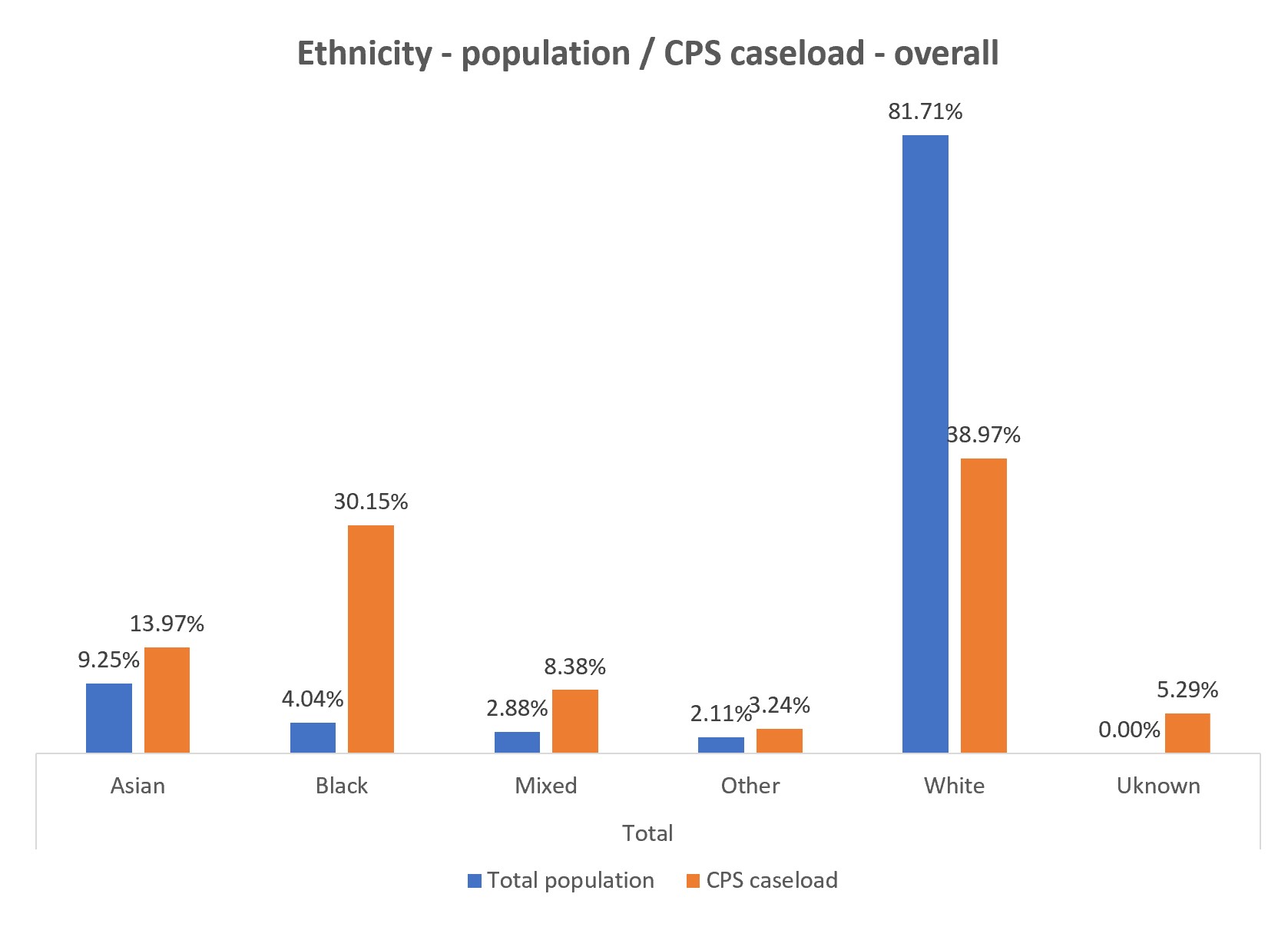
Ethnicity - Area breakdown
The breakdown of defendants by ethnic background varies considerably across CPS Areas. In Mersey-Cheshire (the smallest Area with lowest number of defendants), 96% of defendants have a White background. In London, by contrast, 54% of defendants are Black and 19% are White. The North West, West Midlands, and Yorkshire and Humberside are more similar in profile, with Black ranging from 13% (North West) to 18% (West Midlands) and White ranging from 35% (West Midlands) to 54% (Yorkshire and Humberside).
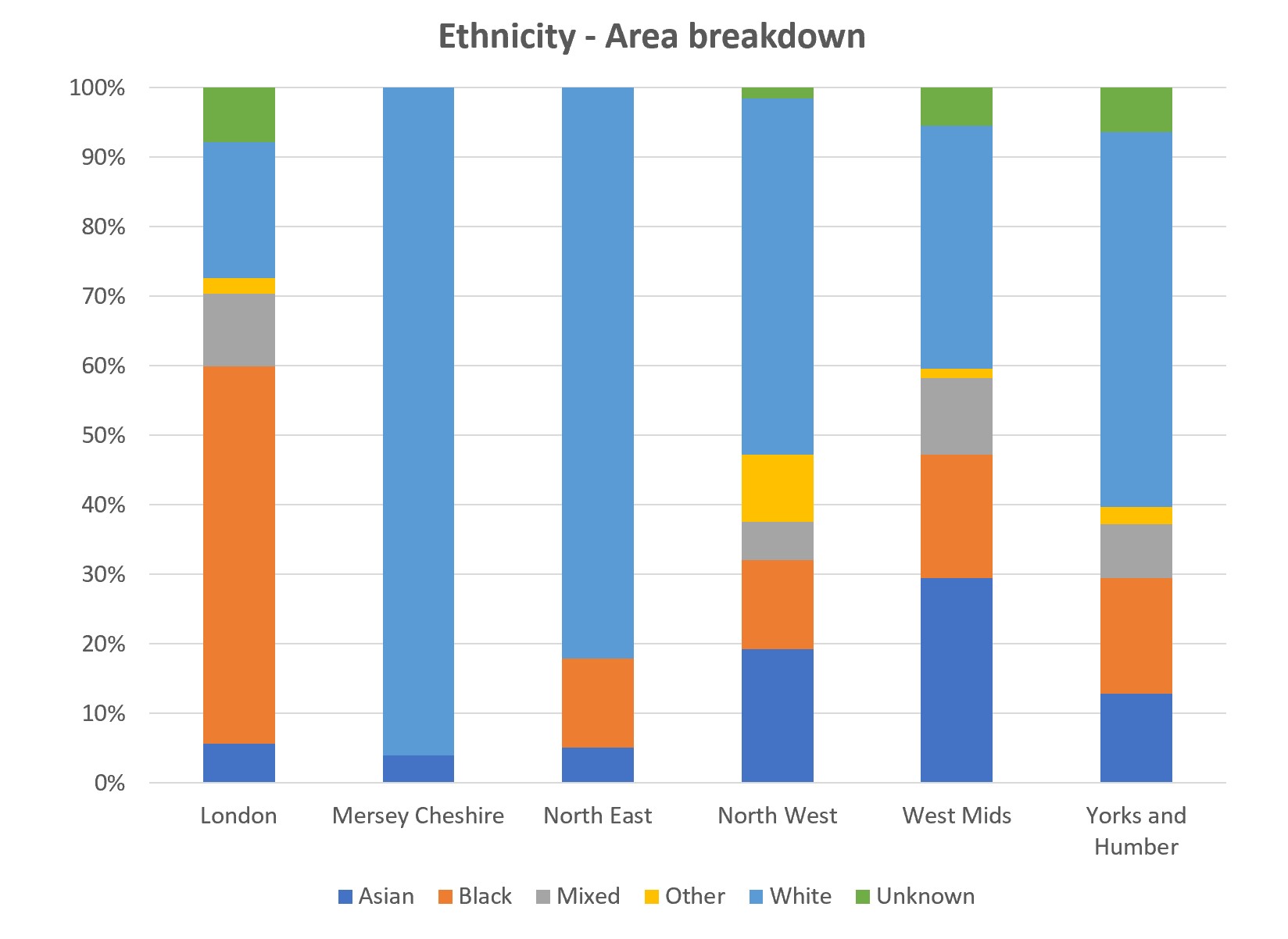
Ethnicity by population, CPS caseload and Area breakdown
In all Areas (other than Mersey Cheshire), the proportion of ‘Black’ defendants is greater in the CPS caseload than the population in that particular Area.
In all Areas (other than Mersey Cheshire and the North East), the proportion of ‘Mixed’ defendants is greater in the CPS caseload than the population in that particular Area.
The same is true for ‘Asian’ defendants in all Areas, other than London.
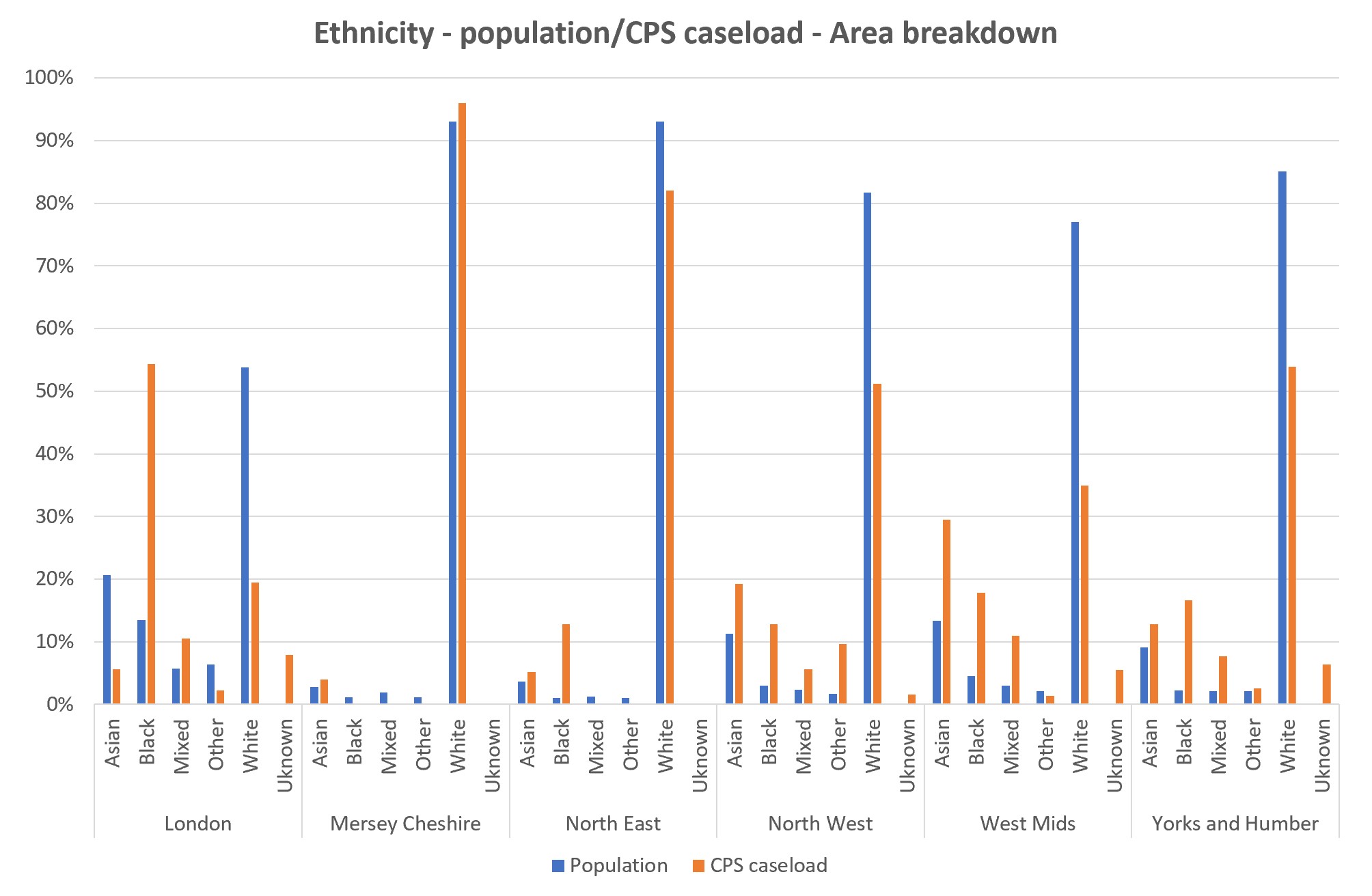
Ethnicity by whether primary or secondary defendant
This graph illustrates the defendant ethnic background and whether they are the principal or secondary party. Broadly, the proportions of defendants considered to be principal or secondary are similar across each category of ethnic background.
To note - There are more principal than secondary defendants, as the nature of the police investigation is that it is likely to concentrate on identifying and building a case against principals.
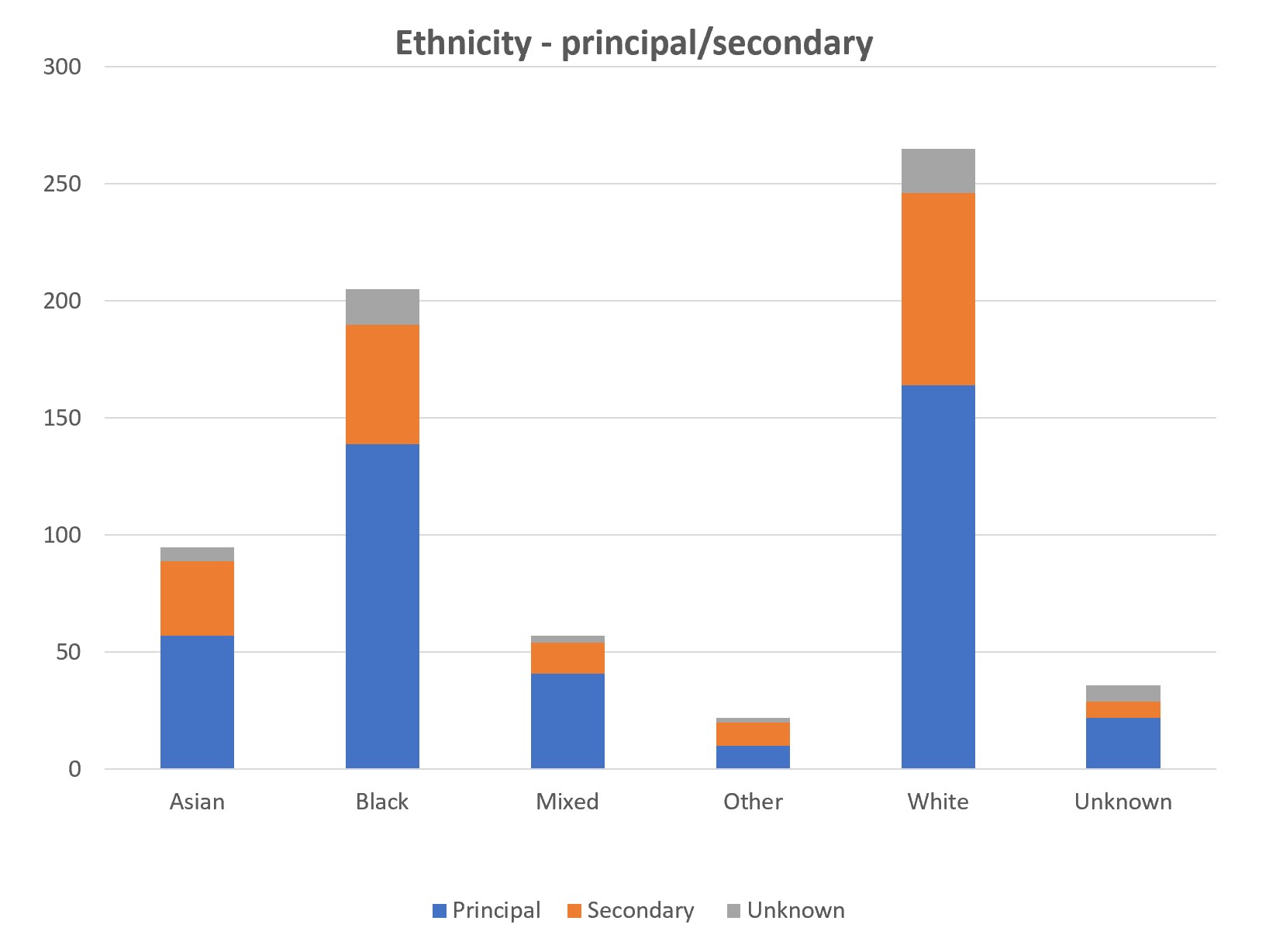
Age and Ethnicity
Comparing age and ethnicity groupings, there are two particularly large groups – Black defendants aged 18-24, and White defendants aged 30-59.
| Age of defendant | Asian | Black | Mixed | White | Other | Unknown |
|---|---|---|---|---|---|---|
| 14-17 | 4 | 33 | 14 | 41 | 2 | 1 |
| 18-24 | 46 | 109 | 24 | 67 | 9 | 16 |
| 25-29 | 24 | 20 | 5 | 46 | 3 | 4 |
| 30-59 | 20 | 41 | 14 | 106 | 8 | 14 |
| 60-69 | 0 | 1 | 0 | 5 | 0 | 0 |
| 60-69 | 0 | 1 | 0 | 0 | 0 | 1 |
| 70-79 | 1 | 0 | 0 | 0 | 0 | 0 |
| Unknown | 0 | 1 | 0 | 0 | 0 | 1 |
| Total | 95 | 205 | 57 | 265 | 22 | 36 |

Joint Enterprise pilot – next steps
As of February 2024, the CPS will commence a full national scheme in all CPS Areas comprising a mandatory Joint Enterprise Monitoring Code ‘flag’ on the CPS Case Management System (CMS) for all cases of homicide and attempted homicide brought on a Joint Enterprise basis.
A report of homicide and attempted homicide cases brought on a joint enterprise basis broken down by the protected characteristics of ethnicity, sex, age and disability will be produced annually.
The CPS will convene a scrutiny panel in January 2024 with a focus on joint enterprise cases where evidence of gang association is a feature.
The CPS will undertake a review of its guidance on gang-related offending in consultation with stakeholders.